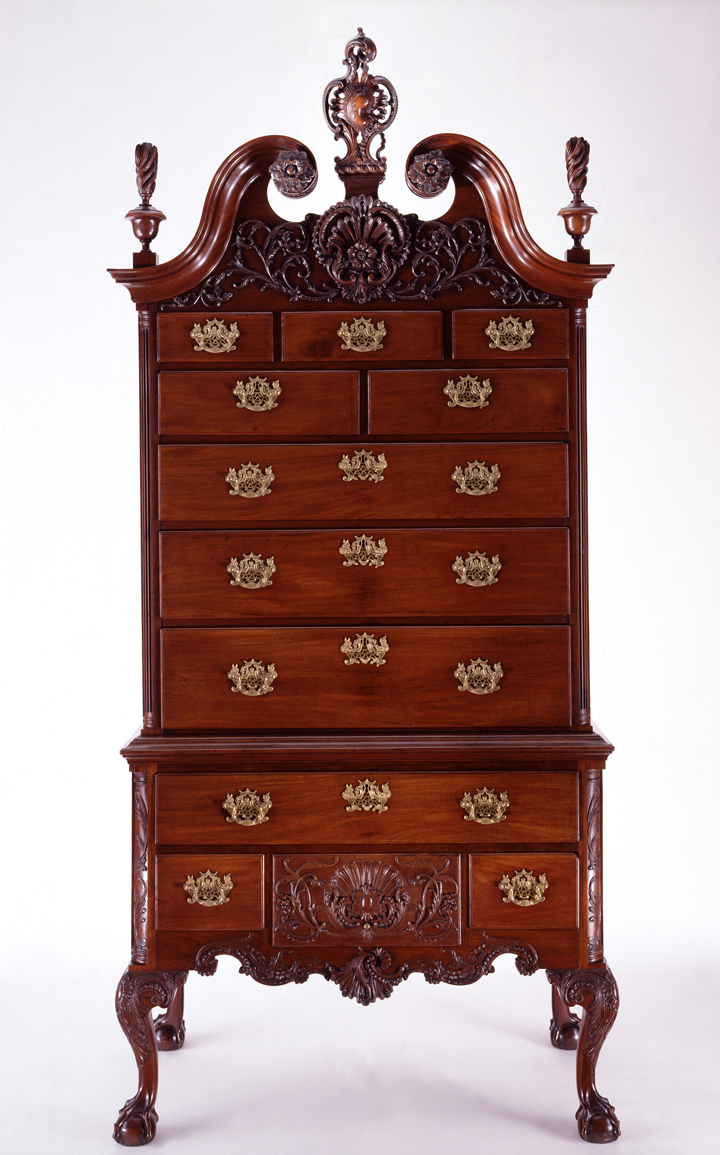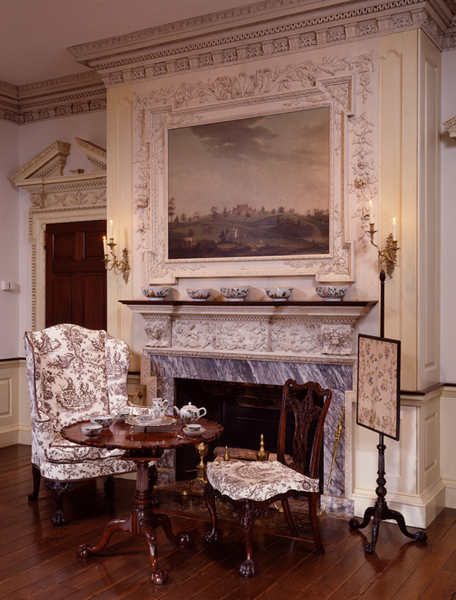‿Peggy Olley – Associate Conservator of Furniture and Woodwork
Solid joinery and turning, elaborate rococo etching, and handsome woods are hallmarks of the finest early American furniture from Philadelphia. In collaboration with the Center for American Art at the Philadelphia Museum of Art, Winterthur'southward almanac Sewell C. Biggs Piece of furniture Forum, held March 5 through 8, focused on Philadelphia'south 18th- and 19th-century furniture and material culture. Below are a few highlights from the sold-out conference—which included more than 300 attendees, including 13 scholarship recipients; 23 presentations by senior and young scholars, dealers, and collectors; and behind-the-scenes tours of the Philadelphia Museum of Art, Winterthur, and Philadelphia historic houses Stenton and Mountain Pleasant.
One specifically interesting lecture from the many presentations was from Laura Keim, Curator, Stenton and Historic Germantown, who presented new work of the iconic Blue Book of Philadelphia furniture, which put into perspective what collectors can trust from the publication and what warrants more scrutiny.
Conference attendees were also very interested in the presentation past Alexandra Kirtley and Peggy Olley, whose lecture "A New Radiance: The Latrobe/Bridport Furniture Revealed" offered insight into the furniture of Latrobe and Bridport from the perspective of both curator and conservator.
The conference speakers emphasized that while experts know quite a bit about certain aspects of Philadelphia piece of furniture and its makers, there is much left to notice. Along the same theme of new exploration, there was an emphasis by many briefing speakers on the influence of German language and other non-English makers and users of article of furniture in Philadelphia. Speakers discussed the diversity of Philadelphia furniture and the importance of studying influences from the Irish, Scots, German, French, and other furnituremaking traditions.
Winterthur is the perfect location for a conference on Philadelphia piece of furniture. The collection of Philadelphia article of furniture featured in Winterthur's In Woods gallery is quite impressive, spanning more than than a century, from 1700 to 1835 including:

Pembroke table, Adam Hains, Philadelphia, Pennsylvania, 1790–95. Gift of Henry Francis du Pont, 1957.669.

High Chest, Philadelphia, Pennsylvania, 1755–75. Gift of Henry Francis du Pont, 1957.506.
Miriam and Michael Gratz owned the high chest to a higher place. Married in Philadelphia in 1769, their marriage merged ii prominent Jewish families that had extensive trading connections. The couple acquired some of the grandest piece of furniture carved in the Philadelphia style of the 1760s. Popularly called a highboy, the handsome mahogany chest of drawers is usually displayed in the Port Royal Parlor at Winterthur.

Port Royal Parlor. Photo: Gavin Ashworth
While du Pont enjoyed collecting decorative arts, he as well assembled a significant collection of architectural details. Port Royal Parlor is one such architectural interior that du Pont acquired from Philadelphia and had reassembled at Winterthur. Port Royal was the country habitation of Edward Stiles, congenital in 1762, on Frankford Creek, due north of Philadelphia. Stiles, a planter and merchant from Port Imperial, Bermuda, had prospered in the West Indies trade. The woodwork in the Port Royal Parlor at Winterthur is original to the house in Philadelphia.

Blackwell Parlor. Photo: Gavin Ashworth
The compages in Blackwell Parlor likewise was original to another Philadelphia house at 224 Pine Street. The richly carved doorways showcased in Blackwell Parlor are an outstanding example of 18th-century American architecture.
Philadelphia was a thriving city during the 18th century. The number of immigrants from Europe rose quickly in the mid- 1700s. Equally a outcome, the demand for household appurtenances and the craftsman to make these goods intensified. Later on in the 1790s, the city flourished as the new capital letter of the United States. Even George Washington called Philadelphia domicile.
As the 2104 Furniture Forum made clear, from its colonial ancestry and through the Industrial Age, Philadelphia remained a fundamental hub for the product of fine piece of furniture and etching in America.
Mark your calendars for the 2015 Sewell C. Biggs Piece of furniture Forum on March iii–7. For more information, visit winterthur.org/furnitureforum.
Mail service by Hilary Seitz, Marketing & Communication Department, in collaboration with Greg Landrey, director of Library, Drove Management and Academic Programs, and Catharine Dann Roeber, Elizabeth and Robert Owens Curatorial Fellow.
0 Response to "‿Peggy Olley – Associate Conservator of Furniture and Woodwork"
Post a Comment